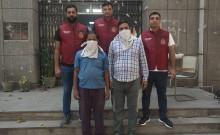
On 10 March last year, a food inspector collected samples of Maggi noodles from a market in Barabanki in Uttar Pradesh and sent it to the Regional Public Analyst Laboratory in Gorakhpur for testing.
The tests revealed more than permissible levels of lead and monosodium glutamate (MSG) in the samples, and started the chain of events that has literally brought down Nestle India's ₹1,300 crore market for Maggi noodles annually in the country.
However, a dispute has emerged within the food safety department about who deserves credit for first exposing Maggi's dangerous lead and MSG contents.
So far, Barabanki's food safety inspector VK Pandey has been hailed as the man behind the expose.
In several interviews, Pandey has described how his team collected Maggi samples last year, sent it for tests and then notified Nestle over the excess lead and MSG, and then sent the samples for further tests to the Central Food Laboratory in Kolkata to confirm that Maggi was indeed dangerous for consumption.
"We collected the samples of almost every product from a shop and sent it for test at Gorakhpur's Regional Public Analyst Laboratory. Two weeks later, the report came that it was containing Monosodium Glutamate (MSG) beyond the permissible limit. We sent a notice to Nestle, the producer company, and Easy Day, the seller. But instead of following routine procedures to deposit a fine and withdraw the product for a while and then bring it back in the market without using MSG, the company challenged our laboratory report," Pandey had told Mail Today.
In fact, other food safety officers were all praise for Pandey.
"It was Pandey's own initiative. We don't ask our officers to go after anyone, unless there is a serious cause for caution, such as during festivals. Nonetheless, we encourage them to not differentiate between national or international brands. The focus should be on collecting samples of food products which are consumed a lot," Ram Araj Maurya, additional commissioner (administration), UP Food Safety and Drug Administration Department, told The Indian Express.
However, another food safety inspector, Pandey's junior, has now come forward to say that it was he who first collected the Maggi sample in Barabanki and got it tested.
Sanjay Singh, a 1998 batch food inspector, has accused his boss of taking the credit for the expose, though it was he who had done the legwork.
"I am the man behind the investigation against Nestle India's two-minute noodle," Singh told the Times of India.
"Had the department not backed me in my investigation of adulteration in the popular brand, the world would not have known the truth about how multi-national food companies compromise with our health," Singh said.
Singh told the paper that he had collected the Maggi samples in Barabanki, and even after the Gorakhpur lab tests showed excess MSG, he sent them for a second test to confirm the results.
"I notified Nestle about the irregularities. The firm challenged the tests and demanded a fresh test at the Central Food Laboratory in Kolkata. Even there, the results were the same and I stood vindicated," he said.
Singh stood by his claim in another interview to India Samvad.
Pandey, on the other hand, has acknowldeged Singh's work but maintained that he was the one to initiate action against the company.
"Every individual has been given a specific task in the administrative hierarchy. Sanjay collected the sample and sent it to the laboratory. However, it was I who took action after the reports mentioned presence of high level of chemicals in Maggi," he told TOI.
Despite the internal squabble for claiming credit over exposing the presence of hazardous ingredients in Maggi noodles , it is safe to say that it was the Uttar Pradesh Food Safety unit in Barabanki that first blew the lid off Maggi noodles.










